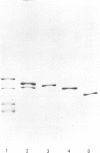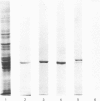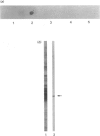Abstract
At least four hepatic isoenzymes of cytochrome P-450 were purified and characterized from rats treated with 3-methylcholanthrene. A monoclonal antibody developed against one of the forms (designated cytochrome P-450 MC-B) and polyclonal antibodies against others were used to demonstrate that form MC-B is immunologically distinct from other methylcholanthrene-inducible forms. Limited N-terminal amino acid sequencing showed that cytochrome P-450 MC-B has a primary structure that differs from the N-terminal sequences of other established rat isoenzymes. Cytochrome P-450 MC-B has a minimum Mr of 53,000, a CO-reduced spectral maximum at 448 nm, a Soret maximum of 417 nm in the absolute oxidized spectrum and a pattern of substrate preferences that differs from those of the other methylcholanthrene-induced forms. The other forms (MC-A, MC-C and MC-D) share characteristics with isoenzymes previously reported by other investigators.
Full text
PDF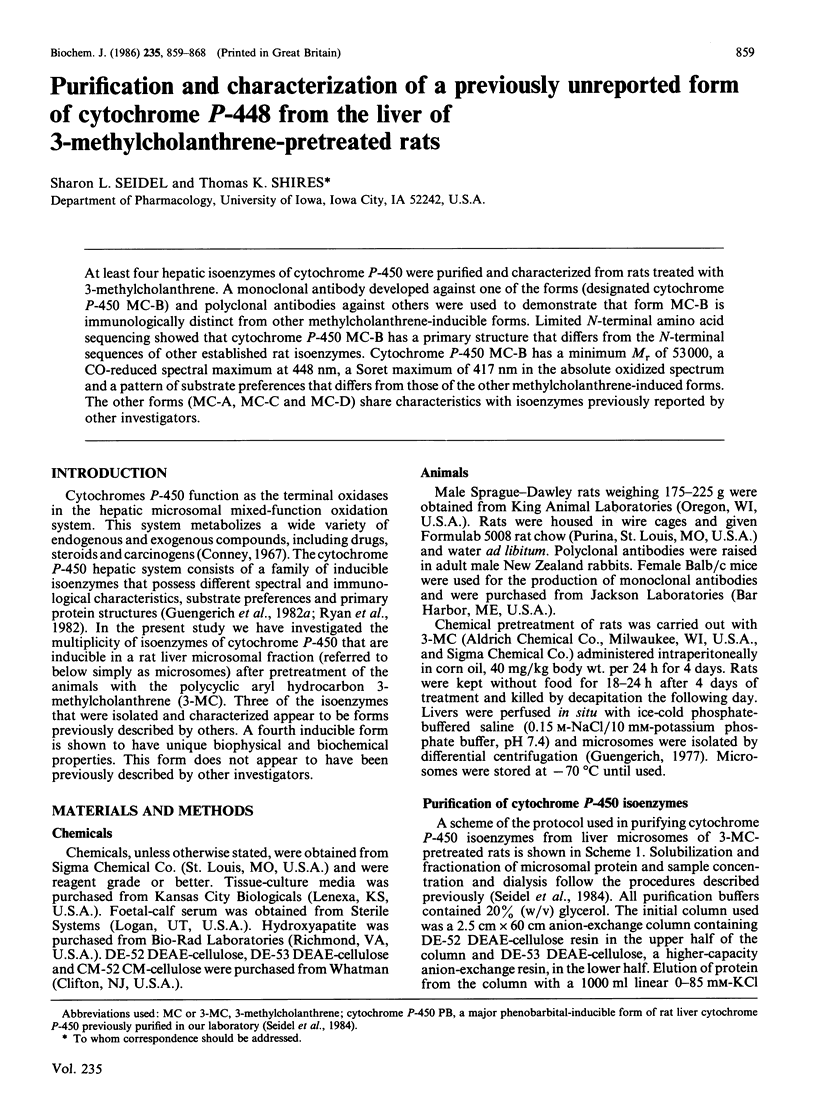
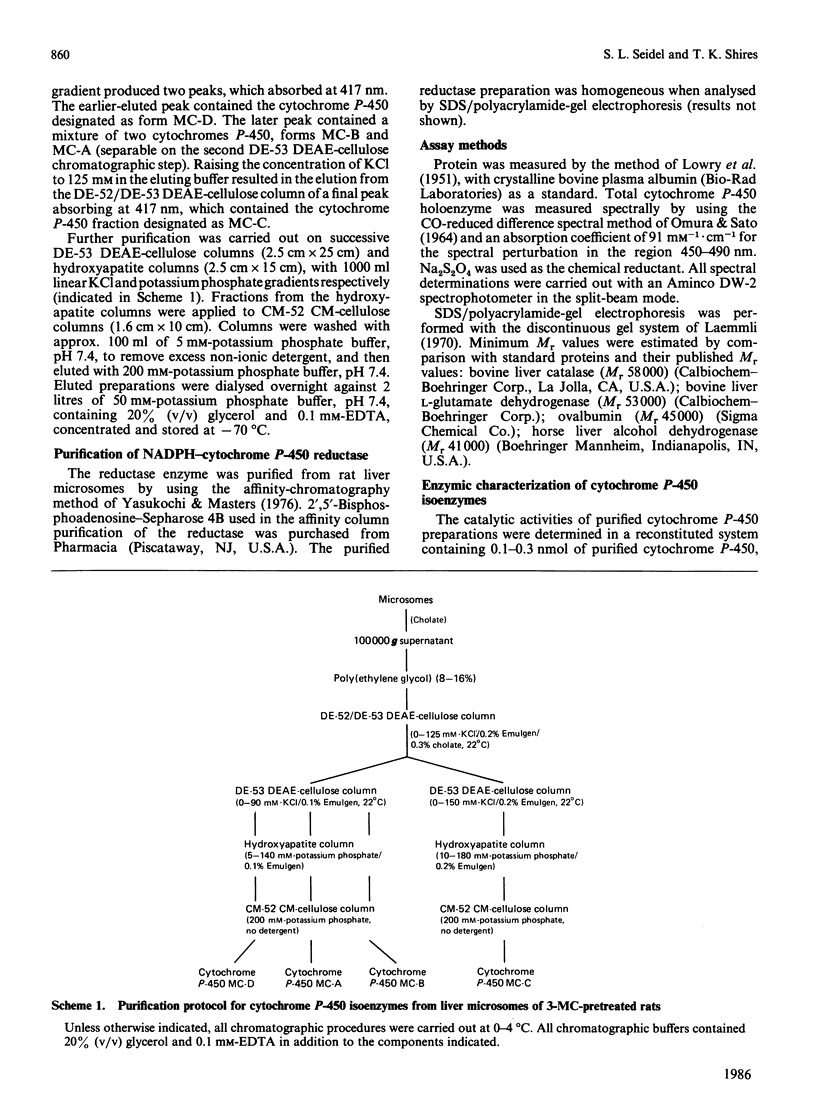
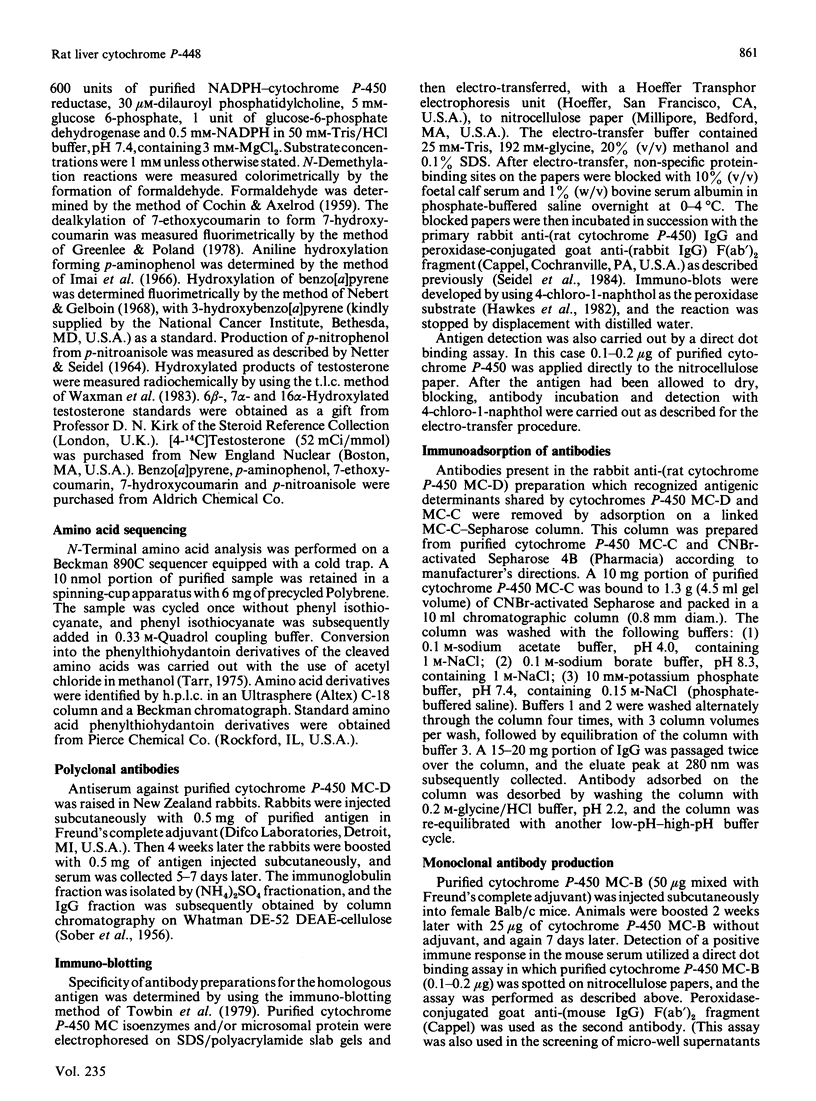
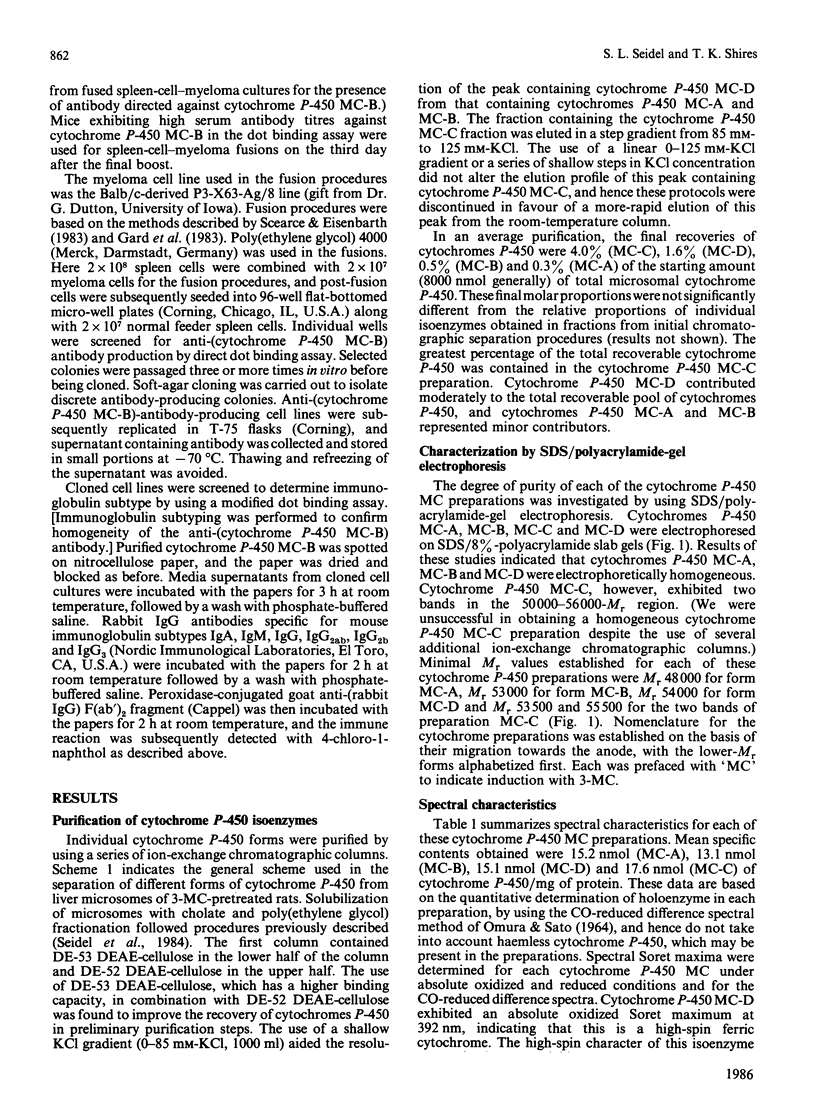
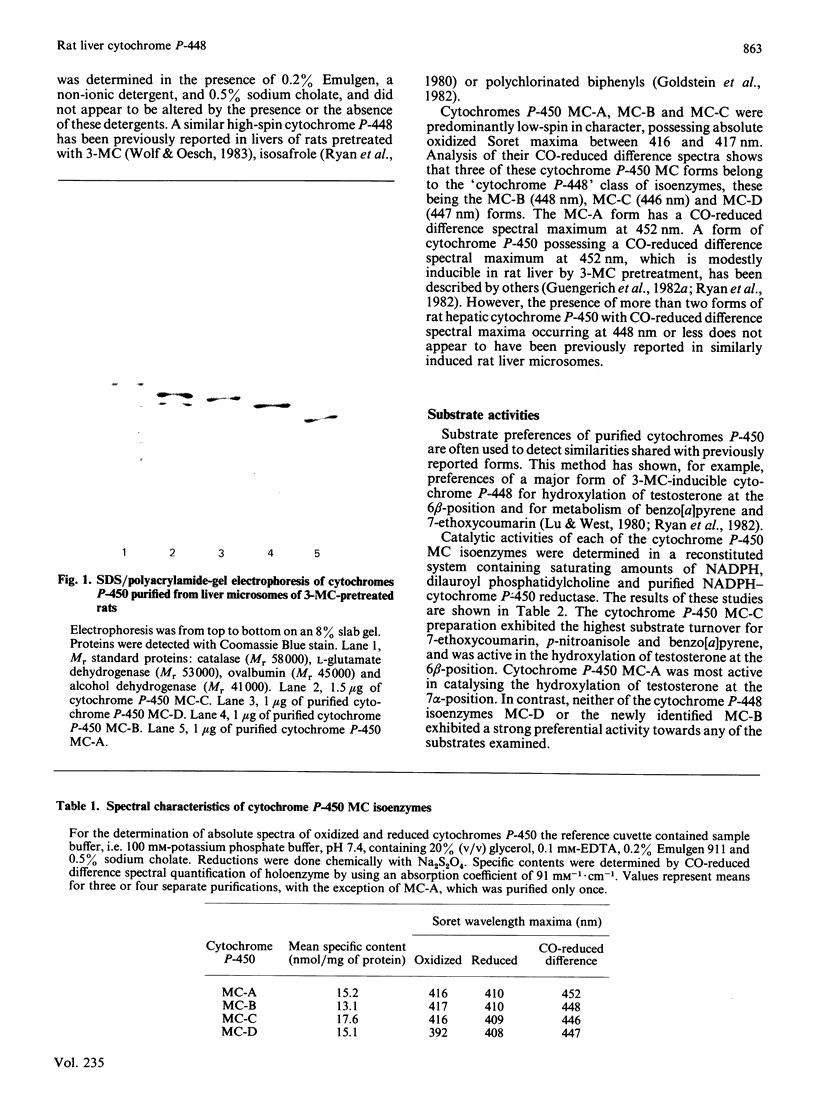
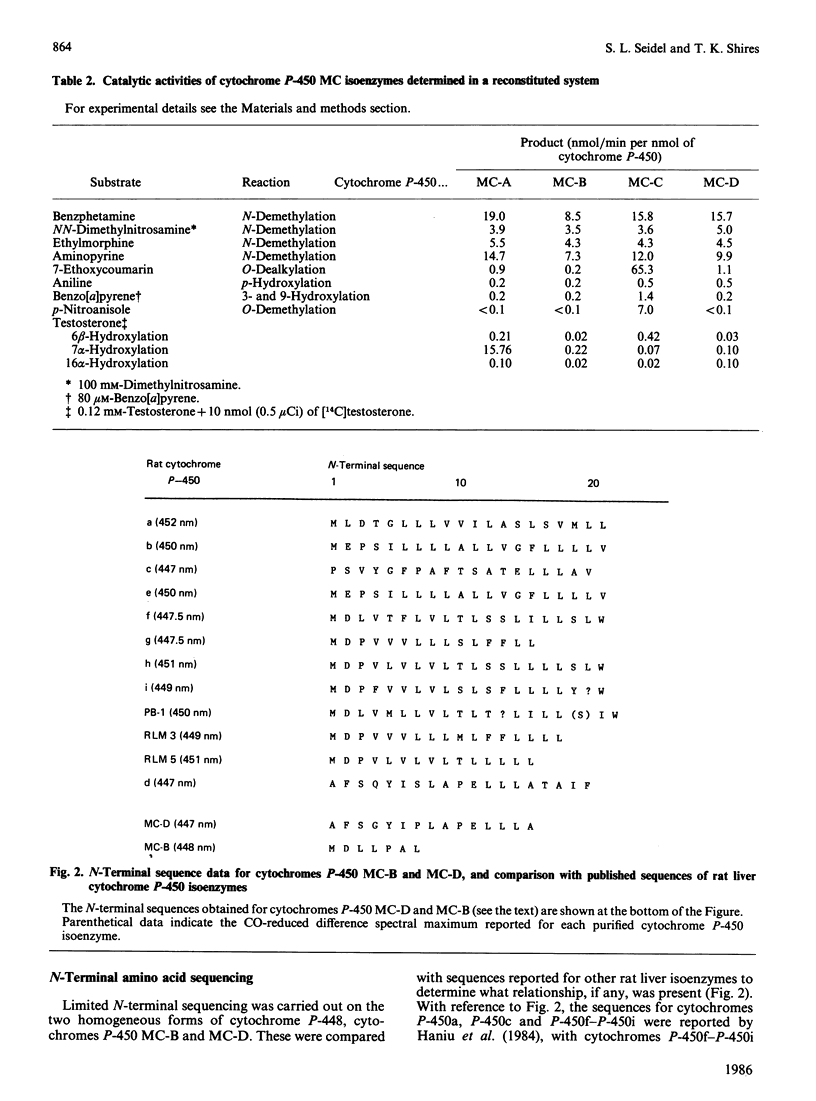
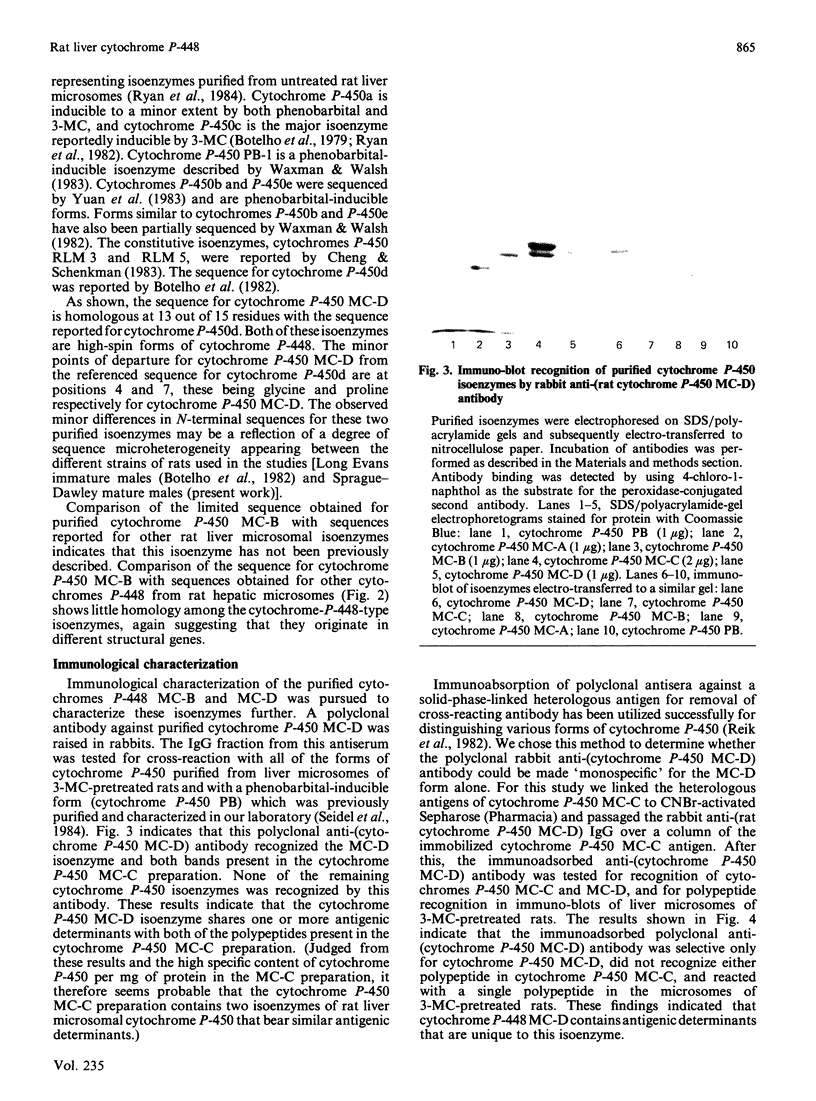
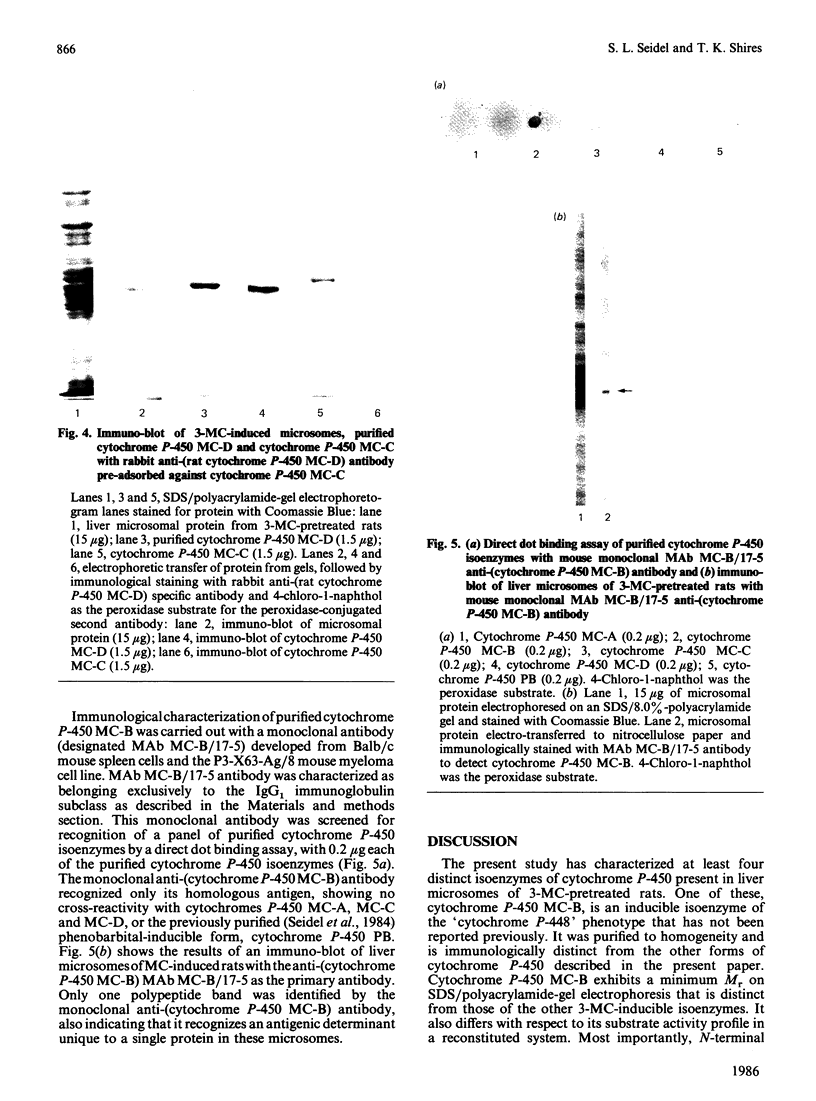
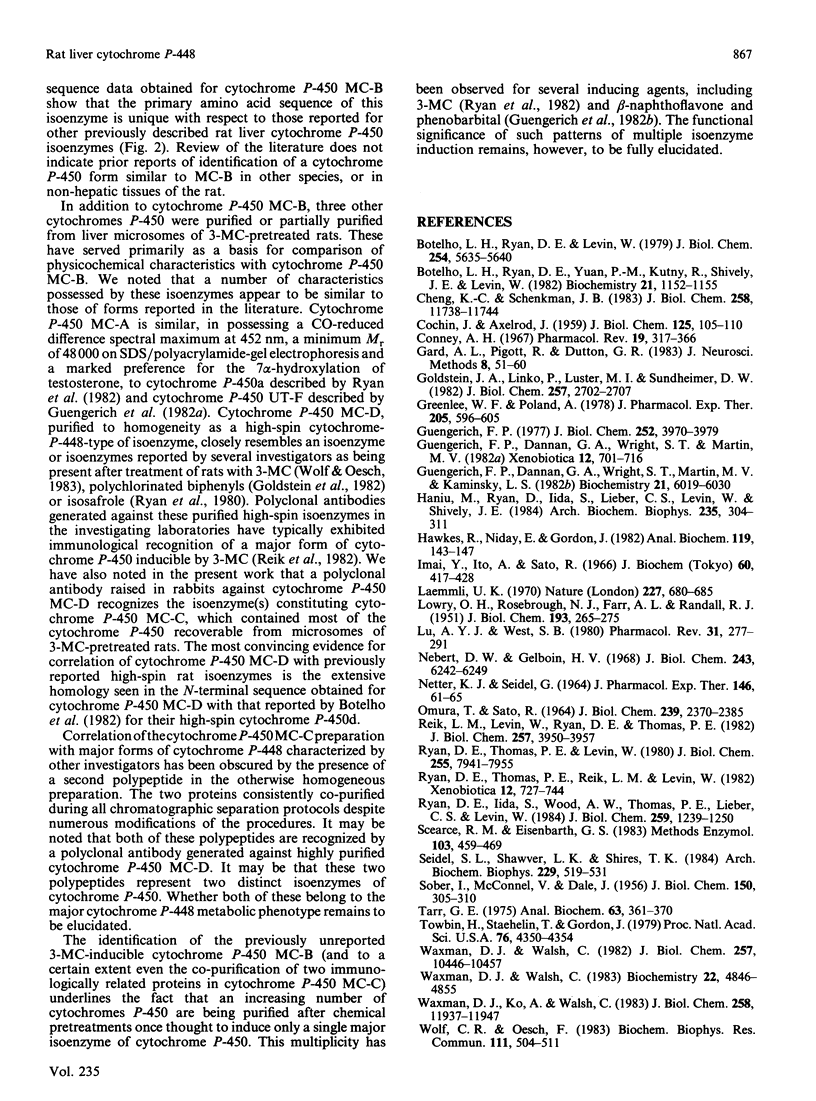
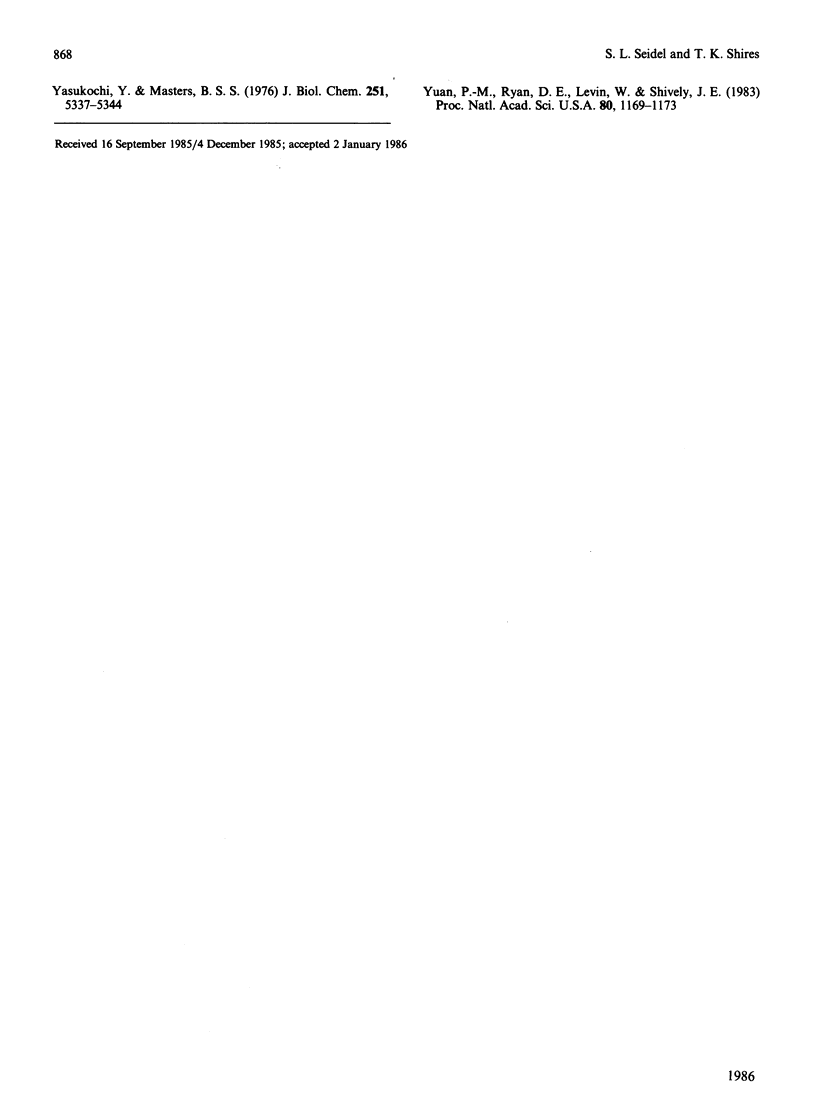
Images in this article
Selected References
These references are in PubMed. This may not be the complete list of references from this article.
- Botelho L. H., Ryan D. E., Levin W. Amino acid compositions and partial amino acid sequences of three highly purified forms of liver microsomal cytochrome P-450 from rats treated with polychlorinated biphenyls, phenobarbital, or 3-methylcholanthrene. J Biol Chem. 1979 Jul 10;254(13):5635–5640. [PubMed] [Google Scholar]
- Botelho L. H., Ryan D. E., Yuan P. M., Kutny R., Shively J. E., Levin W. Amino-terminal and carboxy-terminal sequence of hepatic microsomal cytochrome P-450d, a unique hemoprotein from rats treated with isosafrole. Biochemistry. 1982 Mar 16;21(6):1152–1155. doi: 10.1021/bi00535a007. [DOI] [PubMed] [Google Scholar]
- COCHIN J., AXELROD J. Biochemical and pharmacological changes in the rat following chronic administration of morphine nalorphine and normorphine. J Pharmacol Exp Ther. 1959 Feb;125(2):105–110. [PubMed] [Google Scholar]
- Cheng K. C., Schenkman J. B. Testosterone metabolism by cytochrome P-450 isozymes RLM3 and RLM5 and by microsomes. Metabolite identification. J Biol Chem. 1983 Oct 10;258(19):11738–11744. [PubMed] [Google Scholar]
- Conney A. H. Pharmacological implications of microsomal enzyme induction. Pharmacol Rev. 1967 Sep;19(3):317–366. [PubMed] [Google Scholar]
- Gard A. L., Pigott R., Dutton G. R. A solid-phase beta-galactosidase ELISA for detecting and quantifying monoclonal antibody binding to dissociated cell cultures of postnatal rodent cerebellum. J Neurosci Methods. 1983 May;8(1):51–60. doi: 10.1016/0165-0270(83)90051-1. [DOI] [PubMed] [Google Scholar]
- Goldstein J. A., Linko P., Luster M. I., Sundheimer D. W. Purification and characterization of a second form of hepatic cytochrome P-448 from rats treated with a pure polychlorinated biphenyl isomer. J Biol Chem. 1982 Mar 10;257(5):2702–2707. [PubMed] [Google Scholar]
- Greenlee W. F., Poland A. An improved assay of 7-ethoxycoumarin O-deethylase activity: induction of hepatic enzyme activity in C57BL/6J and DBA/2J mice by phenobarbital, 3-methylcholanthrene and 2,3,7,8-tetrachlorodibenzo-p-dioxin. J Pharmacol Exp Ther. 1978 Jun;205(3):596–605. [PubMed] [Google Scholar]
- Guengerich F. P., Dannan G. A., Wright S. T., Martin M. V., Kaminsky L. S. Purification and characterization of liver microsomal cytochromes p-450: electrophoretic, spectral, catalytic, and immunochemical properties and inducibility of eight isozymes isolated from rats treated with phenobarbital or beta-naphthoflavone. Biochemistry. 1982 Nov 9;21(23):6019–6030. doi: 10.1021/bi00266a045. [DOI] [PubMed] [Google Scholar]
- Guengerich F. P., Dannan G. A., Wright S. T., Martin M. V., Kaminsky L. S. Purification and characterization of microsomal cytochrome P-450s. Xenobiotica. 1982 Nov;12(11):701–716. doi: 10.3109/00498258209038945. [DOI] [PubMed] [Google Scholar]
- Guengerich F. P. Separation and purification of multiple forms of microsomal cytochrome P-450. Activities of different forms of cytochrome P-450 towards several compounds of environmental interest. J Biol Chem. 1977 Jun 10;252(11):3970–3979. [PubMed] [Google Scholar]
- Haniu M., Ryan D. E., Iida S., Lieber C. S., Levin W., Shively J. E. NH2-terminal sequence analyses of four rat hepatic microsomal cytochromes P-450. Arch Biochem Biophys. 1984 Dec;235(2):304–311. doi: 10.1016/0003-9861(84)90202-9. [DOI] [PubMed] [Google Scholar]
- Hawkes R., Niday E., Gordon J. A dot-immunobinding assay for monoclonal and other antibodies. Anal Biochem. 1982 Jan 1;119(1):142–147. doi: 10.1016/0003-2697(82)90677-7. [DOI] [PubMed] [Google Scholar]
- Imai Y., Ito A., Sato R. Evidence for biochemically different types of vesicles in the hepatic microsomal fraction. J Biochem. 1966 Oct;60(4):417–428. doi: 10.1093/oxfordjournals.jbchem.a128453. [DOI] [PubMed] [Google Scholar]
- LOWRY O. H., ROSEBROUGH N. J., FARR A. L., RANDALL R. J. Protein measurement with the Folin phenol reagent. J Biol Chem. 1951 Nov;193(1):265–275. [PubMed] [Google Scholar]
- Laemmli U. K. Cleavage of structural proteins during the assembly of the head of bacteriophage T4. Nature. 1970 Aug 15;227(5259):680–685. doi: 10.1038/227680a0. [DOI] [PubMed] [Google Scholar]
- Lu A. Y., West S. B. Multiplicity of mammalian microsomal cytochromes P-45. Pharmacol Rev. 1979 Dec;31(4):277–295. [PubMed] [Google Scholar]
- NETTER K. J., SEIDEL G. AN ADAPTIVELY STIMULATED O-DEMETHYLATING SYSTEM IN RAT LIVER MICROSOMES AND ITS KINETIC PROPERTIES. J Pharmacol Exp Ther. 1964 Oct;146:61–65. [PubMed] [Google Scholar]
- Nebert D. W., Gelboin H. V. Substrate-inducible microsomal aryl hydroxylase in mammalian cell culture. I. Assay and properties of induced enzyme. J Biol Chem. 1968 Dec 10;243(23):6242–6249. [PubMed] [Google Scholar]
- OMURA T., SATO R. THE CARBON MONOXIDE-BINDING PIGMENT OF LIVER MICROSOMES. I. EVIDENCE FOR ITS HEMOPROTEIN NATURE. J Biol Chem. 1964 Jul;239:2370–2378. [PubMed] [Google Scholar]
- Reik L. M., Levin W., Ryan D. E., Thomas P. E. Immunochemical relatedness of rat hepatic microsomal cytochromes P-450c and P-450d. J Biol Chem. 1982 Apr 10;257(7):3950–3957. [PubMed] [Google Scholar]
- Ryan D. E., Iida S., Wood A. W., Thomas P. E., Lieber C. S., Levin W. Characterization of three highly purified cytochromes P-450 from hepatic microsomes of adult male rats. J Biol Chem. 1984 Jan 25;259(2):1239–1250. [PubMed] [Google Scholar]
- Ryan D. E., Thomas P. E., Levin W. Hepatic microsomal cytochrome P-450 from rats treated with isosafrole. Purification and characterization of four enzymic forms. J Biol Chem. 1980 Aug 25;255(16):7941–7955. [PubMed] [Google Scholar]
- Ryan D. E., Thomas P. E., Reik L. M., Levin W. Purification, characterization and regulation of five rat hepatic microsomal cytochrome P-450 isozymes. Xenobiotica. 1982 Nov;12(11):727–744. doi: 10.3109/00498258209038947. [DOI] [PubMed] [Google Scholar]
- Scearce R. M., Eisenbarth G. S. Production of monoclonal antibodies reacting with the cytoplasm and surface of differentiated cells. Methods Enzymol. 1983;103:459–469. doi: 10.1016/s0076-6879(83)03032-3. [DOI] [PubMed] [Google Scholar]
- Seidel S. L., Shawver L. K., Shires T. K. Detection of phenobarbital-induced cytochrome P-450 in rat hepatic microsomes using an enzyme-linked immunosorbent assay. Arch Biochem Biophys. 1984 Mar;229(2):519–531. doi: 10.1016/0003-9861(84)90183-8. [DOI] [PubMed] [Google Scholar]
- Tarr G. E. A general procedure for the manual sequencing of small quantities of peptides. Anal Biochem. 1975 Feb;63(2):361–370. doi: 10.1016/0003-2697(75)90358-9. [DOI] [PubMed] [Google Scholar]
- Towbin H., Staehelin T., Gordon J. Electrophoretic transfer of proteins from polyacrylamide gels to nitrocellulose sheets: procedure and some applications. Proc Natl Acad Sci U S A. 1979 Sep;76(9):4350–4354. doi: 10.1073/pnas.76.9.4350. [DOI] [PMC free article] [PubMed] [Google Scholar]
- Waxman D. J., Ko A., Walsh C. Regioselectivity and stereoselectivity of androgen hydroxylations catalyzed by cytochrome P-450 isozymes purified from phenobarbital-induced rat liver. J Biol Chem. 1983 Oct 10;258(19):11937–11947. [PubMed] [Google Scholar]
- Waxman D. J., Walsh C. Cytochrome P-450 isozyme 1 from phenobarbital-induced rat liver: purification, characterization, and interactions with metyrapone and cytochrome b5. Biochemistry. 1983 Sep 27;22(20):4846–4855. doi: 10.1021/bi00289a035. [DOI] [PubMed] [Google Scholar]
- Waxman D. J., Walsh C. Phenobarbital-induced rat liver cytochrome P-450. Purification and characterization of two closely related isozymic forms. J Biol Chem. 1982 Sep 10;257(17):10446–10457. [PubMed] [Google Scholar]
- Wolf C. R., Oesch F. Isolation of a high spin form of cytochrome P-450 induced in rat liver by 3-methylcholanthrene. Biochem Biophys Res Commun. 1983 Mar 16;111(2):504–511. doi: 10.1016/0006-291x(83)90335-2. [DOI] [PubMed] [Google Scholar]
- Yasukochi Y., Masters B. S. Some properties of a detergent-solubilized NADPH-cytochrome c(cytochrome P-450) reductase purified by biospecific affinity chromatography. J Biol Chem. 1976 Sep 10;251(17):5337–5344. [PubMed] [Google Scholar]
- Yuan P. M., Ryan D. E., Levin W., Shively J. E. Identification and localization of amino acid substitutions between two phenobarbital-inducible rat hepatic microsomal cytochromes P-450 by micro sequence analyses. Proc Natl Acad Sci U S A. 1983 Mar;80(5):1169–1173. doi: 10.1073/pnas.80.5.1169. [DOI] [PMC free article] [PubMed] [Google Scholar]



